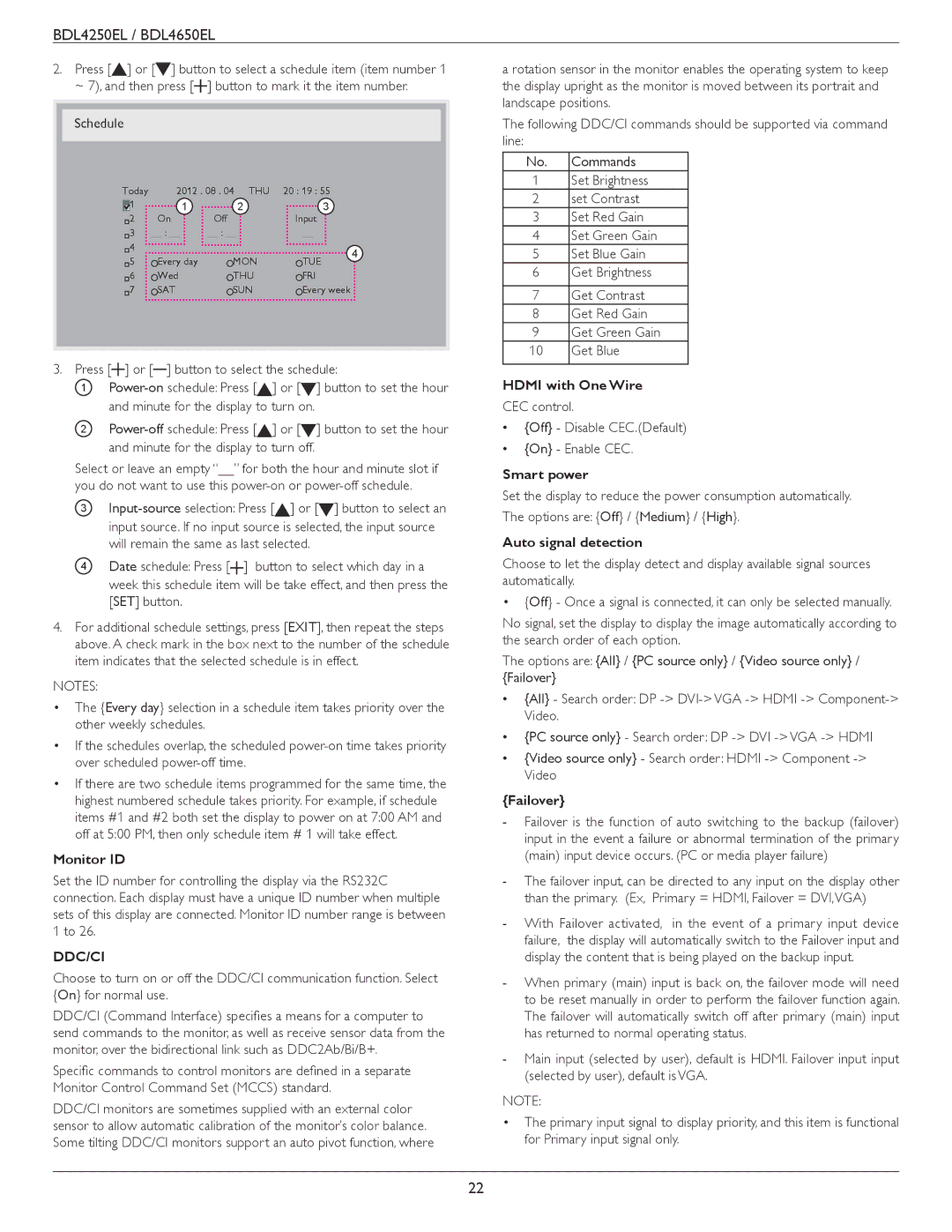
BDL4250EL / BDL4650EL
2.Press [![]() ] or [
] or [![]() ] button to select a schedule item (item number 1 ~ 7), and then press [
] button to select a schedule item (item number 1 ~ 7), and then press [![]() ] button to mark it the item number.
] button to mark it the item number.
Schedule
Today | 2012 . 08 . 04 THU | 20 : 19 : 55 |
| ||
1 | 1 | 2 | 3 |
| |
2 | On | Off | Input |
| |
3 | _ : _ | _ : _ | _ |
| |
4 |
|
|
| 4 | |
5 | Every day | MON | TUE | ||
| |||||
6 | Wed | THU | FRI |
| |
7 | SAT | SUN | Every week |
| |
3. Press [![]() ] or [ ] button to select the schedule:
] or [ ] button to select the schedule:
1![]() ] or [
] or [![]() ] button to set the hour and minute for the display to turn on.
] button to set the hour and minute for the display to turn on.
2![]() ] or [
] or [![]() ] button to set the hour and minute for the display to turn off.
] button to set the hour and minute for the display to turn off.
Select or leave an empty “__” for both the hour and minute slot if you do not want to use this
3![]() ] or [
] or [![]() ] button to select an input source. If no input source is selected, the input source will remain the same as last selected.
] button to select an input source. If no input source is selected, the input source will remain the same as last selected.
4Date schedule: Press [![]() ] button to select which day in a week this schedule item will be take effect, and then press the [SET] button.
] button to select which day in a week this schedule item will be take effect, and then press the [SET] button.
4.For additional schedule settings, press [EXIT], then repeat the steps above. A check mark in the box next to the number of the schedule item indicates that the selected schedule is in effect.
NOTES:
•The {Every day} selection in a schedule item takes priority over the other weekly schedules.
•If the schedules overlap, the scheduled
•If there are two schedule items programmed for the same time, the highest numbered schedule takes priority. For example, if schedule items #1 and #2 both set the display to power on at 7:00 AM and off at 5:00 PM, then only schedule item # 1 will take effect.
Monitor ID
Set the ID number for controlling the display via the RS232C connection. Each display must have a unique ID number when multiple sets of this display are connected. Monitor ID number range is between 1 to 26.
DDC/CI
Choose to turn on or off the DDC/CI communication function. Select {On} for normal use.
DDC/CI (Command Interface) specifies a means for a computer to send commands to the monitor, as well as receive sensor data from the monitor, over the bidirectional link such as DDC2Ab/Bi/B+.
Specific commands to control monitors are defined in a separate Monitor Control Command Set (MCCS) standard.
DDC/CI monitors are sometimes supplied with an external color sensor to allow automatic calibration of the monitor’s color balance. Some tilting DDC/CI monitors support an auto pivot function, where
a rotation sensor in the monitor enables the operating system to keep the display upright as the monitor is moved between its portrait and landscape positions.
The following DDC/CI commands should be supported via command line:
No. | Commands |
1 | Set Brightness |
2 | set Contrast |
3 | Set Red Gain |
4 | Set Green Gain |
5 | Set Blue Gain |
6 | Get Brightness |
7 | Get Contrast |
8 | Get Red Gain |
9 | Get Green Gain |
10 | Get Blue |
HDMI with One Wire
CEC control.
•{Off} - Disable CEC.(Default)
•{On} - Enable CEC.
Smart power
Set the display to reduce the power consumption automatically. The options are: {Off} / {Medium} / {High}.
Auto signal detection
Choose to let the display detect and display available signal sources automatically.
•{Off} - Once a signal is connected, it can only be selected manually.
No signal, set the display to display the image automatically according to the search order of each option.
The options are: {All} / {PC source only} / {Video source only} / {Failover}
•{All} - Search order: DP
•{PC source only} - Search order: DP
•{Video source only} - Search order: HDMI
{Failover}
NOTE:
•The primary input signal to display priority, and this item is functional for Primary input signal only.
22
